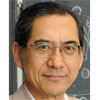
Speaker:
Toshi Tajima
Institution:
UC Irvine, Dept. of Phys. & Astron.

Date:
Thursday, October 17, 2013
Time:
3:30 pm
Location:
RH 101
|
The science of laser acceleration has matured to the extent that we now see routinely GeV electron acceleration over cm distances, starting from the cradle of collective acceleration research of early years. On the other hand the laser technology has been lacking the ability to deliver high rep rate and high efficiency for the high intensity operation. The development of the fiber laser based concept Coherent Amplification Network (CAN) has now enabled the highly efficient, high rep rated fiber laser with large energy, large intensity laser pulses. Thus the CAN laser may be able to serve as an ideal driver for high luminosity accelerators such as a future collider, including a gamma-gamma collider[1]. In addition laser accelerators have some advantages such as their compactness, which can serve well in many applications. For example, the CAN laser is capable of driving ADS (accelerator driven systems) in a simpler system [2], proton therapy accelerators as well as of producing laser-driven gamma rays applicable to nuclear detection, nuclear pharmacology, etc.
The laser acceleration is unique in pursuing extremely high energies (up to PeV) (but not necessarily with high luminosity), in which we could investigate extreme high energy phenomena such as the test of the Special Theory of Relativity [3]. Recently the wakefield acceleration mechanism has been also adopted as an acceleration mechanism for the ZeV cosmic ray genesis that is not hampered by the radiation energy loss suffered by the prevailing theory of the Fermi acceleration [4]. Further, the high fluence laser of CAN may be used for exploring to detect weakly interacting ‘vacuum fields’ such as Dark Matter fields [5].
The exciting prospect is that these developments naturally connect broad disciplines of physicists and astronomers such as laser physicists, plasma physicists, high energy physicists, and astrophysicists.
[1] W. Chou, G. Mourou, N. Solyak, T. Tajima, M. Velasco, HFiTT – Higgs Factory in Tevatron Tunnel. Fermilab-TM-2558-APC (2013).
[2] G. Mourou, W. Brocklesby, T. Tajima, and J. Limpert, Nature Photon. 7, 258 (2013).
[3] T. Tajima, M. Kando, and M. Teshima, Prog. Theor. Phys. 125, 617 (2011).
[4] T. Ebisuzaki and T. Tajima, arXiv: 1306.0970 [astro-ph.HE] (2013).
[5] T. Tajima and K. Homma, Inter. J. Modern Phys. A 27, 1230027 (2012).
* I dedicate this lecture to Professor Norman Rostoker.
|
Host:
Peter Taborek
Attachments:
